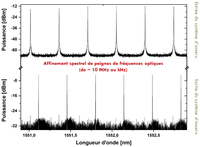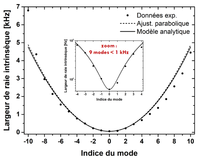 Optical frequency combs obtained from mode-locked laser diodes are potential candidates for WDM networks. However, their lines exhibit usually a broad optical linewidth ( 1-100 MHz). Thus their use is incompatible for high order modulation formats WDM based systems. This thesis investigates one solution to overcome this limitation. It consists of using a feed-forward heterodyne technique to reduce the frequency noise of each comb-line and consequently their optical linewidths.
Optical frequency combs obtained from mode-locked laser diodes are potential candidates for WDM networks. However, their lines exhibit usually a broad optical linewidth ( 1-100 MHz). Thus their use is incompatible for high order modulation formats WDM based systems. This thesis investigates one solution to overcome this limitation. It consists of using a feed-forward heterodyne technique to reduce the frequency noise of each comb-line and consequently their optical linewidths.
In a first approach, the technique is applied to a single-mode laser. This allowed us to validate its proper working and to identify the intrinsic limits of the experimental device set up. The latter analysis enabled us to reveal that the minimum achievable frequency noise level by our system, corresponds to a 50 Hz intrinsic optical linewidth spectrum and a 1,6 kHz optical linewidth based on 10 ms observation time.
 This technique is then applied to an actively mode-locked laser diode demonstrating, at our system output, a 21-line optical frequency comb with intrinsic optical linewidths reduced to below 7 kHz. It is worth noting that 9 among them, exhibit sub-kHz linewidths. For an observation time of 10 ms, all lines share the same optical linewidth, almost equal to 37 kHz. We thus show that the timing jitter impacts the technique performances. We also highlight the relevance of such coherence level for coherent optical communication.
This technique is then applied to an actively mode-locked laser diode demonstrating, at our system output, a 21-line optical frequency comb with intrinsic optical linewidths reduced to below 7 kHz. It is worth noting that 9 among them, exhibit sub-kHz linewidths. For an observation time of 10 ms, all lines share the same optical linewidth, almost equal to 37 kHz. We thus show that the timing jitter impacts the technique performances. We also highlight the relevance of such coherence level for coherent optical communication.
Lastly, we study a laser frequency pre-stabilization technique based on a locking to an unbalanced fiber interferometer. When applied to a single-mode laser, the technique showed a reduction of its technical frequency noise, thus leading to a clear improvement of its integrated optical linewidth from 224 kHz to 37 kHz for 3 ms observation time. This first result provides a good support towards the exploration of mode-locked laser diodes potential for metrological applications.
| Olivier LLOPIS | Director of research, LAAS, CNRS | Examinator |
| Abderrahim RAMDANE | Director of research, C2N, CNRS | Examinator |
| Mehdi ALOUINI | Professor, FOTON Institut, CNRS/Univ Rennes | Member |
| Ghaya BAILI | Research Engineer, THALES TRT | Member |
| Frédéric DU BURCK | Professor, LPL, CNRS/Université de Paris 13 | Member |
| Liam BARRY | Professor, RINCE, Dublin City University | Member |
| Pascal BESNARD | Professor, FOTON Institut, CNRS/Univ Rennes | Ph.D. Supervisor |

































